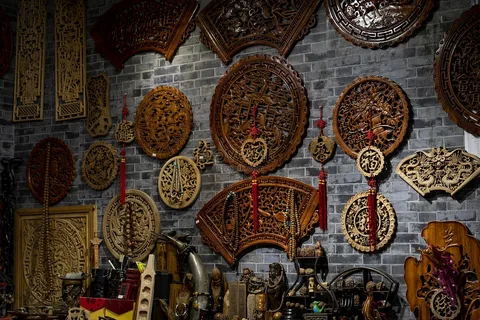Technology in Handicrafts: Preserving Tradition While Innovating
Table of Contents
Introduction
Have you ever wondered how traditional handicrafts can survive in an age dominated by cutting-edge technology? As we move deeper into the digital era, the fusion of technology and tradition becomes not just possible but essential. How can modern tools and ancient crafts coexist, enhancing the beauty and authenticity of each other?
Main Content
The integration of technology in handicrafts is not merely a trend but a necessity to preserve age-old traditions while meeting contemporary demands. Intel, a leading player in technological innovations, is at the forefront of this transformation. By incorporating advanced tools and solutions, Intel is helping artisans worldwide enhance their craftsmanship, streamline production, and reach new markets.
Digital Transformation in Traditional Crafts
The digital transformation in handicrafts involves adopting various technologies that complement traditional methods. 3D printing, for instance, allows artisans to create intricate designs that were previously impossible to achieve by hand. In addition to maintaining the aesthetic integrity of handicrafts, this technology opens up new avenues for innovation and accuracy.
According to a report, the global market for 3D printing in the arts and crafts sector is expected to reach $37.4 billion by 2029, showcasing the significant impact of this technology on traditional craftsmanship.
You may also like: Intel to lay off 15% of its workforce, failed to meet financial projections for the quarter
Enhancing Craftsmanship with AI and Machine Learning
Artificial Intelligence (AI) and Machine Learning (ML) are revolutionizing how artisans design and produce their work. These technologies can analyze patterns, predict trends, and offer personalized recommendations, enabling craftsmen to stay ahead of market demands. Intel’s AI solutions provide artisans with insights into consumer preferences, allowing them to tailor their creations to meet specific needs.
A study by McKinsey & Company reveals that businesses leveraging AI can increase their productivity by up to 40%. For artisans, this means not only preserving traditional skills but also scaling their operations to cater to a global audience.
Sustainable Handicraft Production
Sustainability is a critical aspect of modern handicrafts, and technology plays a vital role in achieving it. By adopting eco-friendly materials and processes, artisans can reduce their environmental footprint. Intel’s smart sensors and analytics tools help craftsmen optimize resource use, minimize waste, and promote sustainable practices.
For instance, the carbon footprint of textile production can be greatly reduced by using sustainable ingredients and colors. The Ellen MacArthur Foundation report suggests that the adoption of circular economy principles in the textile industry could generate savings of $560 billion annually and reduce greenhouse gas emissions.
Bridging the Gap Between Tradition and Innovation
The challenge of integrating technology into handicrafts lies in maintaining the delicate balance between tradition and innovation. While modern tools can enhance efficiency and creativity, they should not overshadow the cultural and historical significance of traditional crafts. Intel’s approach to this integration emphasizes collaboration with artisans, ensuring that technological advancements complement rather than replace traditional methods.
Future Prospects for Technology in Handicrafts
With the progress of technology, handicrafts have a promising future. As more artisans embrace digital tools, the scope for innovation expands, leading to the creation of unique, high-quality products that resonate with modern consumers. Intel’s continuous support for research and development in this field ensures that traditional crafts will thrive in the digital age.
Conclusion
The fusion of technology and handicrafts is a testament to the enduring relevance of traditional crafts in the modern world. By embracing innovation, artisans can preserve their heritage while adapting to contemporary market demands. Intel’s role in this transformation highlights the importance of technology in enhancing craftsmanship, promoting sustainability, and bridging the gap between tradition and innovation. As we look to the future, the synergy between technology and handicrafts promises to create a vibrant, sustainable, and prosperous industry for generations to come.
FAQ
Q1: How is Intel contributing to the innovation in handicrafts?
A1: Intel provides smart technology solutions, such as IoT and AI, that help artisans streamline their production processes, enhance design capabilities, and promote sustainability.
Q2: What role does 3D printing play in traditional crafts?
A2: The artistic quality of handicrafts is preserved while new levels of inventiveness and accuracy are introduced thanks to 3D printing, which enables artists to create complex designs that were previously impossible to construct by hand.
Q3: How does technology promote sustainable handicraft production?
A3: Technology helps artisans optimize resource use, reduce waste, and adopt eco-friendly materials and processes, thereby promoting sustainable practices in handicraft production.
Q4: Can technology overshadow the cultural significance of traditional crafts?
A4: When integrated thoughtfully, technology complements traditional methods without overshadowing their cultural and historical significance, ensuring a balanced approach to innovation.
Q5: What are the prospects for technology in handicrafts?
A5: The future of handicrafts looks promising with technology enabling artisans to create unique, high-quality products, reach broader audiences, and preserve their heritage while adapting to modern market demands.





